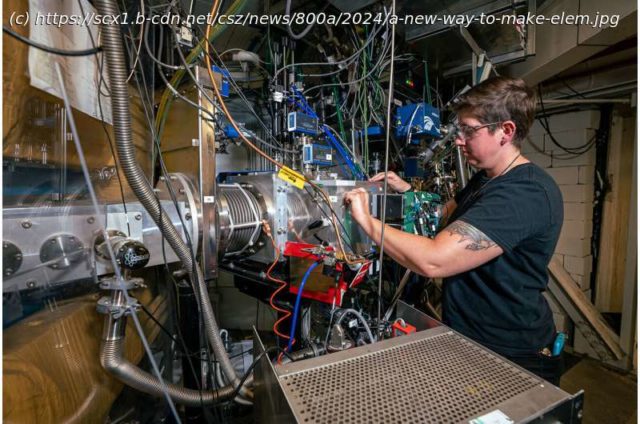Scientists at the Department of Energy’s Lawrence Berkeley National Laboratory (Berkeley Lab) are credited in the discovery of 16 of the 118 known elements. Now they’ve completed the crucial first step to potentially create yet another: element 120.
Scientists at the Department of Energy’s Lawrence Berkeley National Laboratory (Berkeley Lab) are credited in the discovery of 16 of the 118 known elements. Now they’ve completed the crucial first step to potentially create yet another: element 120.
Today, an international team of researchers led by Berkeley Lab’s Heavy Element Group announced that they have made known superheavy element 116 using a titanium beam, a breakthrough that is a key stepping stone towards making element 120. The result was presented today at the Nuclear Structure 2024 conference; the science paper will be posted on the online repository arXiv and has been submitted to the journal Physical Review Letters.
„This reaction had never been demonstrated before, and it was essential to prove it was possible before embarking on our attempt to make 120“, said Jacklyn Gates, a nuclear scientist at Berkeley Lab leading the effort. „Creation of a new element is an extremely rare feat. It’s exciting to be a part of the process and to have a promising path forward.“
The team made two atoms of element 116, livermorium, during 22 days of operations at the lab’s heavy-ion accelerator, the 88-Inch Cyclotron. Making an atom of element 120 would be even rarer, but judging by the rate at which they produced 116, it is a reaction scientists can reasonably search for over the course of several years.
„We needed for nature to be kind, and nature was kind“, said Reiner Kruecken, director of Berkeley Lab’s Nuclear Science Division. „We think it will take about 10 times longer to make 120 than 116. It’s not easy, but it seems feasible now.“
If discovered, element 120 would be the heaviest atom created and would sit on the eighth row of the periodic table. It falls on the shores of the „island of stability“, a theorized group of superheavy elements with unique properties.
While the superheavy elements discovered so far break apart almost instantaneously, the right combination of protons and neutrons could create a more stable nucleus that survives for longer—giving researchers a better chance to study it. Exploring elements at the extremes can provide insights into how atoms behave, test models of nuclear physics, and map out the limits of atomic nuclei.
The recipe for making superheavy elements is simple in theory. You smash together two lighter elements that, combined, have the number of protons you want in your final atom. It’s basic math: 1+2=3.
In practice, of course, it’s incredibly difficult. It can take trillions of interactions before two atoms fuse successfully, and there are limitations on what elements can reasonably be turned into a particle beam or target.






